Menus
- Ninja cyborg, the ultimate warrior
- Discovery
- In the saddle
- On track
- ZX10R Racing Kit
- Conclusion
- Colors
- Accessories
Ninja cyborg, the ultimate warrior
After her victories in the Superbike championship, Kawasaki delivers a new, even more cybernetic opus of its Ninja ZX-10R for its 2016 vintage. The warrior also optimizes her technique with a revamped cycle part for highly accessible efficiency.
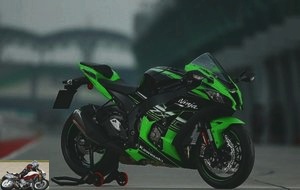
The absolute representative of the Ninja family, the ZX-10R contains the best of the Kawasaki sports range. The ultimate descendant of the GPZ 900 R of 1984, this circuit warrior draws more precisely her genetics from those of the ZX-7 R, ZX-6R, ZX-9R (1990-2000) and of course from the ZX10R of 2004. Common point then of these machines: the famous and very identifiable forced air duct, placed in a central position on the fork crown. With this Ram Air, the 1000 cm3 then develops 184 hp at 11,700 rpm and wears radial front brake calipers. Two years later, modification of the chassis, the engine and the appearance of two exhaust outlets under the saddle. In 2008, the machine received a new frame, four additional horsepower and a silencer in the classic position. Then, the hypersport adopts wider front and rear brake discs, respectively 320 and 220 mm. The wheelbase gains 5 mm, the weight 5 kg and the four-cylinder develops 200 horsepower at 12,500 rpm and a torque of 11.9 da.Nm at 8,700 rpm.
2011 sees the Kawasaki mutate profoundly. New chassis (perimeter frame, BPF – Big Piston Fork, rear shock absorber in horizontal back link type position). The Kawa block now spits 200 hp, under electronic monitoring of the KTRC (anti-skid) and three engine modes. The aesthetic is angular, without compromise. Since then, the ZX10R has accumulated success in the World Superbike championship. After the victory of Tom Sykes in 2012, the manufacturer of Akashi finished again in first place in 2015 with Jonathan Rea. Respectable certainly, but with more and more incisive competitors, Kawasaki once again had to subject her warrior to intensive training. Faced with the BMW S1000RR, Ducati Panigale 1299, Yamaha R1 and of course the over-titled enemy of the Apriia RSV4 paddocks, the green should not fade.
Akashi’s hypersport is reinventing itself this year, notably optimizing its cycle part and its electronics. The mechanical evolution is particularly focused on the weight reduction and the whole should compose a machine of impressive ease and efficiency.
To take stock of its novelty, Kawasaki invites us to Malaysia, on the contrasting and fast track of the Sepang circuit. A prestigious setting in race condition, for a major update.
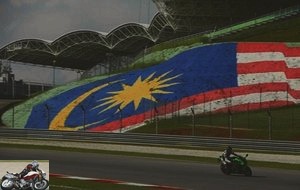
Discovery
Aggressive, unequivocally, the Kawasaki ZX10R already showed the appearance of a beast not lively and high performance. For her new opus, the 2015 Super Bike champion has changed little in terms of aesthetics, still displaying an angular muzzle, but refined in the lower part, pierced in its center by a large air intake. Tapered, two diode optics surround it, topped by a position light. Openwork, the fork head is now linked to the bubble that covers the whole. On the sides, the cutouts forming the fins stretch even more and the new two-tone color happily breaks the lines, energizing the machine when stationary. The back shell would have deserved some touch-ups and / or recesses. The cast aluminum buckle supports aesthetic passage footrests and the reduced seat of the latter. This houses a tool kit of the same format.

The real novelties are just as difficult to distinguish but highly effective and detailed in the Technical section. As a reminder, the Kawasaki ZX10R hypersport is based on a split beam frame, made of cast aluminum. Identical in design, its dimensions evolve of course to accommodate its heart of fire, largely redesigned. The infernal Japanese boiler with multiple victories and now Euro4 certified. Despite this, the 998cc four-cylinder still delivers a maximum power of 200 hp (147.1 kW) at 13,000 rpm (with RAM Air 210 hp – 154.4 kW) and a torque of 11.35 da.Nm at 11,500 rpm. But engine dynamics should improve further in this vintage thanks to important modifications. The moment of inertia of the crankshaft is reduced, the clutch lightened, the air box greatly enlarged.
But above all, the Ninja ZX10R significantly optimizes its cycle part. First, the geometry is reviewed with a Steering column closer to the driver by 7.5 mm, a swing arm stiffened and above all lengthened by 15.8 mm. The Race-Kit option allows you to modulate these values (see corresponding section). The wheelbase increases by 15 mm but the caster retains its value of 107 units. Measures favorable to traction and better control when turning the machine. And what about Race-original Showa suspensions. Developed in the WSBK championship, these elements command respect. At the front, we note the inert gas reservoirs pressurizing the oil in the sleeves and the damping chambers managing the circulation of the fluid. Each tube has a preload adjustment at its top, the screws modulating compression and rebound are located on the damping chamber. The shock absorber is of the same technology and also adjustable in any direction.
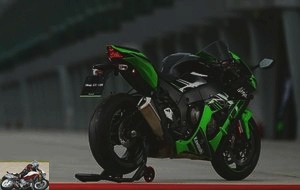
Finally, electronics also make up an important part of the evolutions of the ZX10R, notably with the adoption of a inertial unit, enhancing the effectiveness of other devices by analyzing their reactions. This is how the new S-KTRC anti-skidding, the KIBS anti-lock brakes, the KLCM starting aid, the KEBC engine brake control and the KQS shifter are listened to.. Understood? And the Ohlins electronic steering damper also speaks with the control unit…. Happy who communicates.
For braking, the front axle receives Brembo M50 monobloc radial mount calipers attacking 330 mm discs, put under the pressure of a radial master cylinder of the same origin. All details in the Technical section.
The three-spoke rims are gravity-cast alloy with sidewall valves. They are fitted with Bridgestone Battlax RS10s, guaranteeing excellent performance for outings on circuits. For more efficiency, we will also test Bridgestone Battlax Racing V02 slick casings..
Particularly attractive, the ZX10R has no notable flaws in its presentation. The engine housings are treated to a deep bronze finish and the metal surfaces of the frame and triple trees are treated to a mat or satin finish of great elegance..
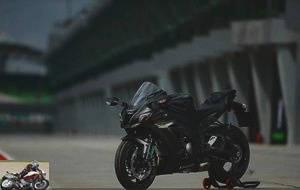
In the saddle
Gaining 22 mm, the seat height now reaches 835 mm, thus positioning the rider in a more efficient position than before. Thus, the ergonomics are in clear progression, with a closer handlebars and a tank spreading less the legs. Switched to the controls, the cockpit also shows careful attention. Almost unchanged, it renews the diode strip of the tachometer, which also acts as a gear change indicator. The LEDs start flashing when the engine speed reaches a threshold preset by the pilot. Under this colored cover, an analog window groups together the classic tachometer, gear indicator, engine clock and temperature as well as information dedicated to the latest on-board technologies: engine mode, engine brake, ABS on or off, anti-slip and stopwatch, l ‘KLCM departure aid, the Quick Shifter and a warning light for the inertial unit.

Everything is controlled from the left chest of drawers via a push button overcoming a rocker button. Fast and didactic, the readability of the whole could be better, particularly those of the additional indications, hardly usable.
The levers are adjustable, the components perfectly adjusted and the cockpit enhancing, giving a sporty atmosphere..
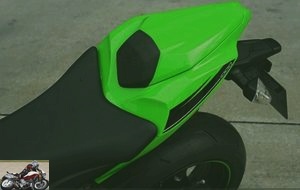
On track
After digesting the many technical elements, it is now time to practice on the Malaysian long ribbon. The 5,543 meters and 15 bends of the Sepang track are just waiting for us. Not very demonstrative, the exhaust is discreet when starting, but presages a serious breath.
The first start is on a standard Bridgestone Battlax RS10 pneumatic ride and under the leadership of Tom Sykes himself. The English pilot plays the luxury marshall to make us discover the circuit, during one lap only, alas. The subtleties will be our responsibility, which we will have the leisure to discover and then try to master throughout the day..
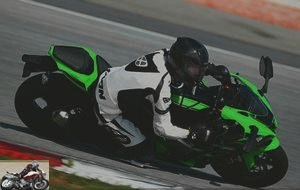
In the heat of the Malaysian climate (36 °), standard tires are put to the test. Over the laps, they lose precision without ever betraying the crew. Most of the sessions are then carried out with the slicks, giving the ZX-10R all its sporting potential..
With the furious noise of a turbine, the Ninja launches her war cries at each go-around. We have to admit that the Kawa block does not lack voice or reach. Beyond 7000 turns, the block launches out to attack the red zone. Effectively showing little inertia, it accelerates with frenzy, the reports being linked without dragging the shifter. Precise, the command makes it possible to evaluate the new gearbox staging and the dynamism provided, in particular on the intermediate gears. At the end of the straights we easily catch a 270 km / h in 6 ° at just under 13,000 laps. The Kawa still has some under rape. Also, the engine power at mid-range authoritatively catapults the ZX10R to the next curve. However, if it impresses most often, the boiler is less brilliant under 6000 revolutions, in the pins. In second, he struggles to make Akashi’s sportswoman shoot out and needs to drop a gear to exploit the plethora of cavalry.
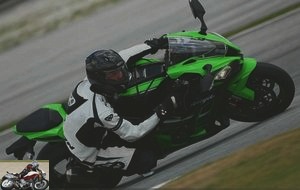
As the sessions progress, the pace increases, only three curves here need to go first. We then take advantage of these tight turns to discover a lively and precise machine. The tight left-right following the pit straight line is a merciless judge. The Ninja shows all her talent, going from one angle to another without downtime. Likewise, it is easy to correct the trajectories with a simple support on the foot or on the handlebars. Ergonomics have improved significantly, optimizing piloting and giving the pilot a lot of ease on board.
The sequences also make it possible to judge the quality of the anti-skating, progressive and to the implementation without delay. The controlled commas then only underline the performance of the system. These reminders also highlight the shock absorber. The constraints gradually compress it, giving a good idea of the support available. Only the strongest accelerations lighten the front axle, making it difficult to lift it…. electronic obliges. Everything is designed for efficiency. We can however deactivate the S-KTRC for more freedom (and risks). Equally noteworthy is the impressive Showa fork, giving a great feeling of control and tightness. Set on the angle in large, fast curves, riveted to the ground, the ZX10R is very stable, following the desired course without fail. And the suspension remains imperial everywhere, effectively limiting mass transfers, even on the strongest decelerations..
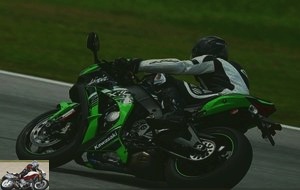
As such, the Kawasaki is capable of the best. Its Brembo M 50 calipers provide as much strength as it does control, with only one finger to grip the lever! Arriving like a ball on the hairpin, we find ourselves "stuck" in the asphalt. The machine slows down with impressive stopping force. In addition, taking the brakes on a curve also has no effect on the behavior of the sportswoman. Finally, the braided hoses provide flawless endurance to the system, under the control of a KIBS optimizing braking and generally avoiding sweeping of the rear wheel..

ZX10R Racing Kit
If, despite all its potential, the ZX10R leaves you hungry for more, equip it with the Racing Kit (more info in the technical section dedicated to the ZX-10R)…. As much to you admit, the machine is transfigured. If we just blame a lack of trunk at low speed to the standard version, the kit gives it a whole new life. Full as an egg, the block gives the best of its connecting rods. On paper, 10 more horses. But in reality, the kit offers much more flavor to the Kawasaki. Not to mention the soundtrack, the vocalizations of which one would think belong more to a fighter plane, punctuated by an audible click of the exhaust at each gas cut. The Ninja never stops pushing and relaunching with force in 2 or even in 3….! A delight. It looks like another engine as it seems even more efficient. The kit fitted here the "Winter Test" version, special series equipped with an approved Akrapovic silencer. And the catalyst was gone, just like the Euro4 standards…. The Raw Ninja refers directly to its competitive counterpart with multiple victories. The price of the option is not yet known (around € 1,500) but undeniably transforms the machine.
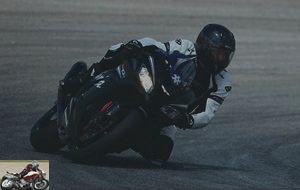
Conclusion
To sum up the green fighter in one word, the most suitable term is: ease. Yes, despite its 210 hp in action, the Kawasaki Ninja ZX10R knows how to surround its mechanical performance with a new transparent and precise cycle part, all under careful control of its ever more efficient electronics. The result is a top-of-the-range tool, a real concentrate of accessible performance, Superbike taken to the streets.
To acquire this ultimate cybernetic warrior, you will have to pay € 17,599 for the black version and € 17,799 in Green Replica, both available now. The special Winter Test series and its Akrapovic silencer claim € 18,699 from February.
Facing her, the Ninja has no shortage of enemies. Foremost among which is its competition partner, the Aprilia RSV4, priced at € 17,200 in RR version (APRC included). To obtain the Swedish blond-golden suspensions and forged wheels, it will take an additional € 2,299, or € 19,499 to add the Racing Pack. The charm of the V4 is an undeniable asset. Another Italian, the Ducati 1199 Panigale and Panigale S claim € 20,990 and € 25,990. Direction Bavaria where the S 1000 RR requires, excluding options, € 17,450. Finally back to Japan, where the new Yamaha R1 is billed at € 18,499, TFT screen as a bonus.
Well placed on the price list, the Kawasaki Ninja ZX10R offers an efficient machine, with an almost obvious grip. Only a lack of character at low revs is detrimental to it, but the Euro4 plague is likely to hit its rivals with the same boredom. And the performances of the ZX10R are the only ones to be available full and complete right now…. In search of the ultimate path, this Ninja may just get you there.
Strong points
- Overall ease
- Racy aesthetics
- Performances
- Efficient electronics
- Efficiency of the chassis
- Optimized ergonomics
- Brilliant braking
- High level suspensions
Weak points
- Engine too timid at low revs
- Readability of instruments improved
Kawasaki ZX-10R technical sheet
Colors
Lime Green (green, KRT Edition)
Metallic Matte Carbon Gray (gray)
Black Winter Test Edition
Accessories
Passenger seat cover
Tank guards
Engine protection pads
Front wheel axle pads
Related articles
-
Police savagery 4 cylinders of 948 cm3, 125 hp and 98.6 Nm, 212 kg, 9.499 euros Unmissable sales success in the midsize segment since its appearance in…
-
Roadster with Sugomi sauce or decarenated sports car A2 licenses have the choice between large bridles, sometimes very badly bridled, and smaller ones,…
-
Kawasaki Ninja 1000 SX motorcycle test
Compromise without compromise 4 cylinders of 1,043 cm3, 142 hp and 111 Nm, 235 kg, from 14,349 euros In 2010, Kawasaki presented its first Z1000SX, a…
-
Evolution or revolution of the ER6-f with the in-line twin of 649 cm3, 68 horsepower for 193 kilos A more sporty look but, paradoxically, a gain in…
-
Cruise missile The ultimate breed of sports cars, the Kawasaki ZZR 1400 is a living myth; the last witness to an almost vanished age when speed and power…
-
2010 Kawasaki Z1000 motorcycle test
The right machine for the bad boys ! Initiated in 1972, the Z saga is a story of heavy mechanics and strong character. After the 900 cc Z1, the first…
-
998 cm3, 210 hp at 13,000 rpm, 11.3 m / kg, 300 km / h, 206 kilos, € 17,799 Breathtaking performance, cutting-edge electronics, pure feel… You may not…
-
A new little sports car accessible to A2 licenses Twin cylinder in-line, 399 cm3, 45 hp at 10,000 rpm, 38 Nm at 8,000 rpm, 168 kilos, from € 5,999…
-
TGV first class Five years ago, Kawasaki presented its first Z1000SX, a road version of its Z 1000 reference roadster. A versatile machine, which has…
-
40 horses at 11,500 rpm 25.7 Nm, 175 kilos with full tank, two colors, € 5,799 An easy and sparkling little trail: what if life on a motorcycle was as…
On the style, to see with my eyes … Otherwise, a linear motor on a Ducati !!! but where we go ….. As well go to BM !
I regret the beautiful ohlins suspensions and the weight gain of the beast but I can’t wait to try it anyway.